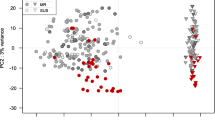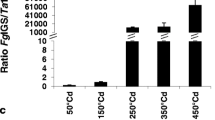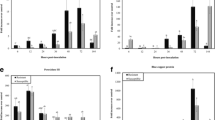Abstract
Fusarium head blight (FHB), primarily caused by Fusarium graminearum Schw., is a destructive disease of wheat (Triticum aestivum L.). Although several genes related to FHB resistance have been reported, global analysis of gene expression in response to FHB infection remains to be explored. The expression patterns of transcriptomes from wheat spikes of FHB-resistant cultivar Ning 7840 and susceptible cultivar Clark were monitored during a period of 72 h after inoculation (hai) with F. graminearum. Microarray analysis, coupled with suppression subtractive hybridization technique, identified 44 significantly differentially expressed genes between cv. Ning 7840 and cv. Clark. More differentially expressed genes were identified from susceptible libraries than from resistance libraries. The up-regulation of defense-related genes in Ning 7840 relative to cultivar Clark occurred during early fungal stress (3–12 hai). Three genes, with unknown function that were up-regulated in cv. Ning 7840 at most time points investigated, might play an important role in enhancing FHB resistance.

Similar content being viewed by others
References
Applied Biosystems (1997) Relative quantification of gene expression. ABI PRISM 7700 sequence detection system user bulletin #2, pp 11–15
Altschul SF, Madden TL, Schaffer AA, Zhang J, Zhang Z, Miller W, Lipman DJ (1997) Gapped BLAST and PSI-BLAST: a new generation of protein database search programs. Nucleic Acids Res 25:3389–3402
Bai GH, Kolb FL, Shaner GE, Domier LL (1999) Amplified fragment length polymorphism markers linked to a major quantitative trait locus controlling scab resistance in wheat. Phytopathology 89:343–348
Bai GH, Shaner GE (2004) Management and resistance in wheat and barley to Fusarium head blight. Annu Rev Phytopathol 42:135–161
Bai GH, Shaner G, Ohm H (2000) Inheritance of resistance to Fusarium graminearum in wheat. Theor Appl Genet 100:1–8
Cao H, Li X, Dong X (1998) Generation of broad-spectrum disease resistance by overexpression of an essential regulatory gene in systemic acquired resistance. Proc Natl Acad Sci U S A 95:6531–6536
Chen LF, Song Y, Xu YG, Nie L, Xu LL (1997) Comparison of activities of superoxide dismutase and catalase between scab-resistant and susceptible wheat varieties. Acta Phytopathologica Sinica 27(3):209–213
Collinge DB, Kragh KM, Mikkelsen JD, Nielsen KK, Rasmussen U, Vad K (1993) Plant chitinases. Plant J 3:31–40
Cordero MJ, Raventos D, San-segundo B (1994) Expression of a maize proteinase inhibitor gene is induced in response to wounding and fungal infection: systemic wound response of a monocot gene. Plant J 6:141–150
Desjardins AE, Hohn TM (1997) Mycotoxins in plant pathogenesis. Mol Plant-Microb Interact 10:147–152
Diatchenko L, Lau YFC, Campbell PA, Chenchik A, Moqadom F, Huang B, Lukyanov K, Gurskaya N, Sverdlov ED (1996) Suppression subtractive hybridization: a method for generating differentially regulated or tissue-specific cDNA probes and libraries. Proc Natl Acad Sci U S A 93:6025–6030
Dunaevskii YE, Gladysheva IP, Pavlukova EB, Beliakova GA, Gladyschev DP, Papisova AI, Larionova NI, Belozersky MA (1997) The anionic protease inhibitor BBWI- 1 from buckwheat seeds: kinetic properties and possible biological role. Physiol Plant 100:483–488
Freeman WM, Robertson, DJ Vrana KE (2000) Fundamentals of DNA hybridization arrays for gene expression analysis. BioTechniques 29:1042–1055
Frey M, Chomet P, Glawischnig E, Stettner C, Grün S (1997) Analysis of a chemical plant defense mechanism in grasses. Science 277:696–699
Glen AE, Hinton DM, Yates IE, Bacon CW (2001) Detoxification of corn antimicrobial compounds as the basis for isolating Fusarium verticillioides and some other Fusarium species from corn. Appl Environ Microbiol 67:2973–2981
Hammond-Kosack KE, Jones JDG (1996) Resistance gene-dependent plant defense responses. Plant Cell 8:1773–1791
Hedge P, Qi R, Abernathy K, Gay C, Dharap S, Gaspard R, Hughes JE, Snesrud E, Lee N, Quackenbush J (2000) A concise guide to cDNA microarray analysis. BioTechniques 29:548–562
Jwa N-S, Agrawal GK, Rakwal R, Park C-H, Agrawal VP (2001) Molecular cloning and characterization of a novel jasmonate-inducuble pathogenesis-realted class 10 protein gene, JIOsPR10, from rice (Oryza sativa L.) seedling leaves. Biochem Biophys Res Commun 286:973–983
Kang Z, Buchenauer H (2000) Ultrastructure and immunocytochemical investigation of pathogen development and host responses in resistant and susceptible wheat spikes infected by F. culmorum. Physiol Mol Plant Pathol 57:255–268
Kruger WM, Pritch C, Staggs R, Muehlbauer GJ (2002) Functional and comparative bioinformatic analysis of expressed genes from wheat spikes infected with Fusarium graminearum. Mol Plant-Microb Interact 15:445–455
Li WL, Faris JD, Muthukrishnan S, Liu DJ, Chen P, Gill BS (2001) Isolation and characterization of novel cDNA clones of acidic chitinases and β-1, 3-glucanases from wheat spikes infected with Fusarium graminearum. Theor Appl Genet 102:353–362
Lu WZ, Chen SH, Wang YZ (eds.) (2001) Research on wheat scab. Beijing, China: Sci Publ House, pp. 136–172
McMullen M, Jones R, Gallenberg D (1997) Scab of wheat and barley: a re-emerging disease of devastating impact. Plant Dis 81:1340–1348
Niemeyer HM (1988) Hydroxamic acids (4-hydroxy-1,4-benzoxazin-3-ones): defence chemicals in the Gramineae. Phytochemistry 27:3349–3358
Ozturk ZN, Talame V, Deyholos M, Michalowski CB, Galbaith DW, Gozukirmisi N, Tuberosa R Bonert HJ (2002) Monitoring large-scale changes in transcript abundance in drought and salt-stressed barley. Plant Mol Biol 48:551–573
Puthoff DP, Nettleton D, Rodermel SR, Baum TJ (2003) Arabidopsis gene expression changes during cyst nematode parasitism revealed by statistical analyses of microarray expression profiles. Plant J 33:911–921
Pritsch C, Muehlbauer GJ, Bushnel WR, Somers DA, Vance CP (2000) Fungal development and induction of defense response genes during early infection of wheat spikes by Fusarium graminearum infection. Mol Plant-Microb Interact 13:159–169
Pritsch C, Vance CP, Bushnel WR, Somers DA, Hohn T.M, Muehlbauer GJ (2001) Systemic expression of defense response genes in wheat spikes as a response to Fusarium graminearum infection. Physiol Mol Plant Pathol 58:1–12
Rommens CM, Kishore GM (2000) Exploiting the full potential of disease-resistance genes for agricultural use. Curr Opin Biotechnol 11:120–125
Schenk PM, Kazan K, Manners JM, Anderson JP, Simpson RS, Wilson IW, Somerville SC, MacLean DJ (2003) Systemic gene expression in Arabidopsis during an incompatible interaction with Alternaria brassicicola. Plant Physiol 132:999–1010
Shroeder HW, Christensen JJ (1963) Factors affecting resistance of wheat to scab caused by Giberella zeae. Phytopathology 53:831–838
Snijers CHA (1990) Fusarium head blight and mycotoxin contamination of wheat, a review. Neth J Plant Pathol 96:187–198
Sturn A, Mlecnik B, Pieler R, Rainer J, Truskaller T, Trajanoski Z (2003) Client-server environment for high-performance gene expression data analysis. Bioinformatics 19:772–773
Trail F, Xu J-R, San Miguel P, Halgren RG and Kistler HC (2003) Analysis of expressed sequence tags from Gibberella zeae (anamorph Fusarium graminearum). Fungal Genet Biol 38:187–197
Xiao K, Bai G, Carver B (2005) Nylon filter arrays reveal differential expression of ESTs in wheat roots under aluminum stress. J Integr Biol 47(7):839–848
Xing DH, Yen Y, Rudd JC, Jin Y (2000) Identification, cloning and sequencing of ESTs related to FHB resistance of wheat. In: 2000 National Fusarium Head Blight Forum, Erlanger, KY, 10–12 Dec, pp. 62–63
Acknowledgements
This work was partially supported by the Great Plains Biotechnology Consortium and the US Wheat and Barley Scab Initiative. We thank Dr. Anne Desjardin for providing the GBZ 3639 strain of F. graminearum; the Oklahoma State University Microarray Core Facility for providing access to microarray equipment, which was supported by the grants from NSF (EOS-0132534) and NIH (2P20RR016478-04, 1P20RR16478-02, and 5P20RR15564-03); and Dr. Jianfa Bai at the Gene Expression Facility at Kansas State University for technical support on RT-PCR. Any opinions, findings, conclusions, or recommendations expressed in this publication are those of the author(s) and do not necessarily reflect the view of the US Department of Agriculture. This is contribution No. 05-277-5 from the Kansas Agricultural Experiment Station, Manhattan, KS.
Author information
Authors and Affiliations
Corresponding author
Electronic supplementary materials
Below is the link to the electronic supplementary material.
Table S1
Sequence of primers used for real time PCR (PDF 23 kb)
Figure S1
Fluorescence signal of eight cDNA templates amplified with wheat beta-actin primers (non-regulated control) indicate equal template concentrations (PDF 45kb)
Figure S2
Microarray (A) and real-time PCR (R) data in log2 ratios from a selected set of genes representing 6 clusters. Log2 ratios are on the Y-axis while the X-axis denotes the time point of inoculation. Letters to the right of the each graph indicate the gene cluster. A positive value indicates up-regulation of gene expression and a negative value indicates down-regulation of gene expression in resistant cv. Ning7840 relative to susceptible cv. Clark. RT-PCR values are from an average of two replicates (PDF 45 kb)
Rights and permissions
About this article
Cite this article
Bernardo, A., Bai, G., Guo, P. et al. Fusarium graminearum-induced changes in gene expression between Fusarium head blight-resistant and susceptible wheat cultivars. Funct Integr Genomics 7, 69–77 (2007). https://doi.org/10.1007/s10142-006-0028-1
Received:
Accepted:
Published:
Issue Date:
DOI: https://doi.org/10.1007/s10142-006-0028-1




